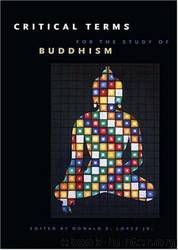Critical Terms for the Study of Buddhism by Donald S. Lopez Jr

Author:Donald S. Lopez, Jr.
Language: eng
Format: azw3
Tags: Religion, Buddhism, General
ISBN: 9780226493145
Publisher: University Of Chicago Press
Published: 2005-11-15T14:37:47+00:00
But this discrimination is itself in the service of a paean to the nondiscriminating amplitude of the Buddha's pedagogy. "I explain the law to creatures, after having recognized their inclinations," he says in Peabody's selection. "I proportion my language to the subject and the strength of each."
It is, 0 Kacyapa, as if a cloud, raising itself above the universe, covered it entirely, hiding all the earth.... Spreading in an uniform manner an immense mass of water, and resplendent with the lightning which escape from its sides, it makes the earth rejoice. And the medicinal plants which have burst from the surface of this earth, the herbs, the bushes, the kings of the forest, little and great trees; the different seeds, and every thing which makes verdure; all the vegetables which are found in the mountains, in the caverns, and in the groves; the herbs, the bushes, the trees, this cloud fills them with joy, it spreads joy upon the dry earth, and it moistens the medicinal plants; and this homogeneous water of the cloud, the herbs and the bushes pump up, every one according to its force and its object... . Absorbing the water of the cloud by their trunks, their twigs, their bark, their branches, their boughs, their leaves, the great medicinal plants put forth flowers and fruits. Each one according to its strength, according to its destination, and conformably to the nature of the germ whence it springs, produces a distinct fruit, and nevertheless there is one homogeneous water like that which fell from the cloud. So, 0 Kacyapa, the Buddha comes into the world, like a cloud which covers the universe ... and teaches the true doctrine to creatures. (Peabody 1844, 398-99)
Presumably the resonance of such a passage for Transcendentalist readers would not come from its promise of "true doctrine," but rather from its focus on a difficult problematic already internal to their Romantic preoccupation with Bilduizg: how a mode of teaching could nurture the individual fates as well as the common needs of those receiving it.
For if ever there was a group as mad for pedagogy as the dramatis personae of the sutras, it must have been the Transcendentalists. With the exception of Thoreau, each of them seemed to attach her or his most vital hope to some practice of viva voce pedagogy-and in each case to one that, independent of university or church credentialing, actively deprecated the claim of authority in favor of that of experiential demand. Also as in the world of the sutras, but much more unusual in the West, the range of these practices-from the Temple School to Margaret Fuller's Conversations to the Concord School of Philosophy-involved people from toddlers to the aged, with no particular phase singled out as uniquely appropriate for education. Thus, that aspect of the Mahayana ideal that refused to differentiate at the level of identity between teacher and learner coincided with their ideal. Even when adults taught young children, as Elizabeth Peabody writes in Record of a
Download
This site does not store any files on its server. We only index and link to content provided by other sites. Please contact the content providers to delete copyright contents if any and email us, we'll remove relevant links or contents immediately.
The Way of Zen by Alan W. Watts(6295)
Ego Is the Enemy by Ryan Holiday(4972)
The Art of Happiness by The Dalai Lama(3855)
The Book of Joy by Dalai Lama(3714)
Why Buddhism is True by Robert Wright(3293)
Spark Joy by Marie Kondo(3093)
Shift into Freedom by Loch Kelly(3035)
Happiness by Matthieu Ricard(2892)
A Monk's Guide to a Clean House and Mind by Shoukei Matsumoto(2789)
The Lost Art of Good Conversation by Sakyong Mipham(2448)
The Meaning of the Library by unknow(2397)
The Third Eye by T. Lobsang Rampa(2175)
The Unfettered Mind: Writings from a Zen Master to a Master Swordsman by Takuan Soho(2165)
Red Shambhala by Andrei Znamenski(2075)
Anthology by T J(2049)
The Diamond Cutter by Geshe Michael Roach(1959)
Thoughts Without A Thinker: Psychotherapy from a Buddhist Perspective by Epstein Mark(1902)
Advice Not Given by Mark Epstein(1769)
Twilight of Idols and Anti-Christ by Friedrich Nietzsche(1766)
